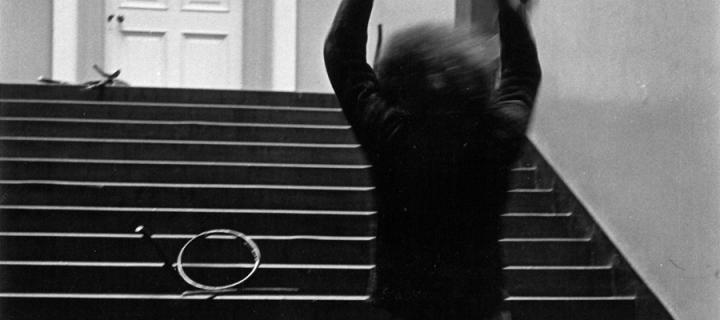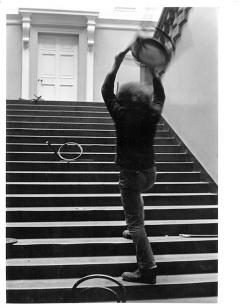2. Stefan Wewerka’s ‘Bentwood Chair Action’ on the grand staircase with Klaus Rinke smashing chair
Stefan Wewerka’s smashing of chairs on the ECA grand staircase was enjoyed by the artists, students, and some visitors, but upset several college tutors.

Stefan Wewerka
One of the most dramatic ‘happenings’ at Strategy: Get Arts was instigated by the charismatic German artist Stefan Wewerka (1928-2013), who came from several generations of artists. His father, Rudolf Wewerka, was a sculptor and founding member of ‘Die Kugel’, who knew Bruno Taut and others associated with late Expressionism.
Wewerka was a freelance artist associated with the Kunsthalle Düsseldorf and was also connected to a number of artists at the Kunstakademie. He appears in both Tony Morgan’s film Description (1970) and Maurico Kagel’s Ludwig van (1969), both shown at SGA. He designed sets for the latter and also appears in the opening sequence shaving and mumbling ‘Beethoven…Bummelei…Bumserei’ and some other nonsensical words.
Smashing of chairs

In the 1960s, Stefan began to cut up and reassemble objects of everyday life and especially chairs. Alexander Hamilton, a student helper at SGA, recalls assisting him source a dozen or so bentwood chairs from Sam Burns’ Yard in Prestonpans.
Wewerka, Klaus Rinke, and other artists and student helpers then proceeded to smash the chairs on the main staircase of ECA, in an unusual nod to the ‘the Odessa Steps’ sequence in Sergei Eisenstein’s Battleship Potemkin (1925).
Wewerka’s broken chairs, arranged at irregular intervals, lay beneath an intervention into the fabric of the building by Blinky Palermo, a wall painting comprising a horizontal band of primary colours, which ran around the architrave.
The smashing of chairs on the grand staircase was simply too much for many college tutors to accept, seen as an abuse of the order and the clean geometry of the entrance vestibule, with some believing that Wewerka’s ‘action’ was tantamount to hooliganism.
Intriguingly, Wewerka would turn from iconoclast to designer later in the 1970s when he designed chair sculptures for TECTA, a company founded in 1956, largely focusing on producing licensed Bauhaus furniture, as well as developing their own design concepts.
For instance, Wewerka would create the three-legged B1 armchair, which was designed according to the Bauhaus principle of 'form follows function'.
C.W.


